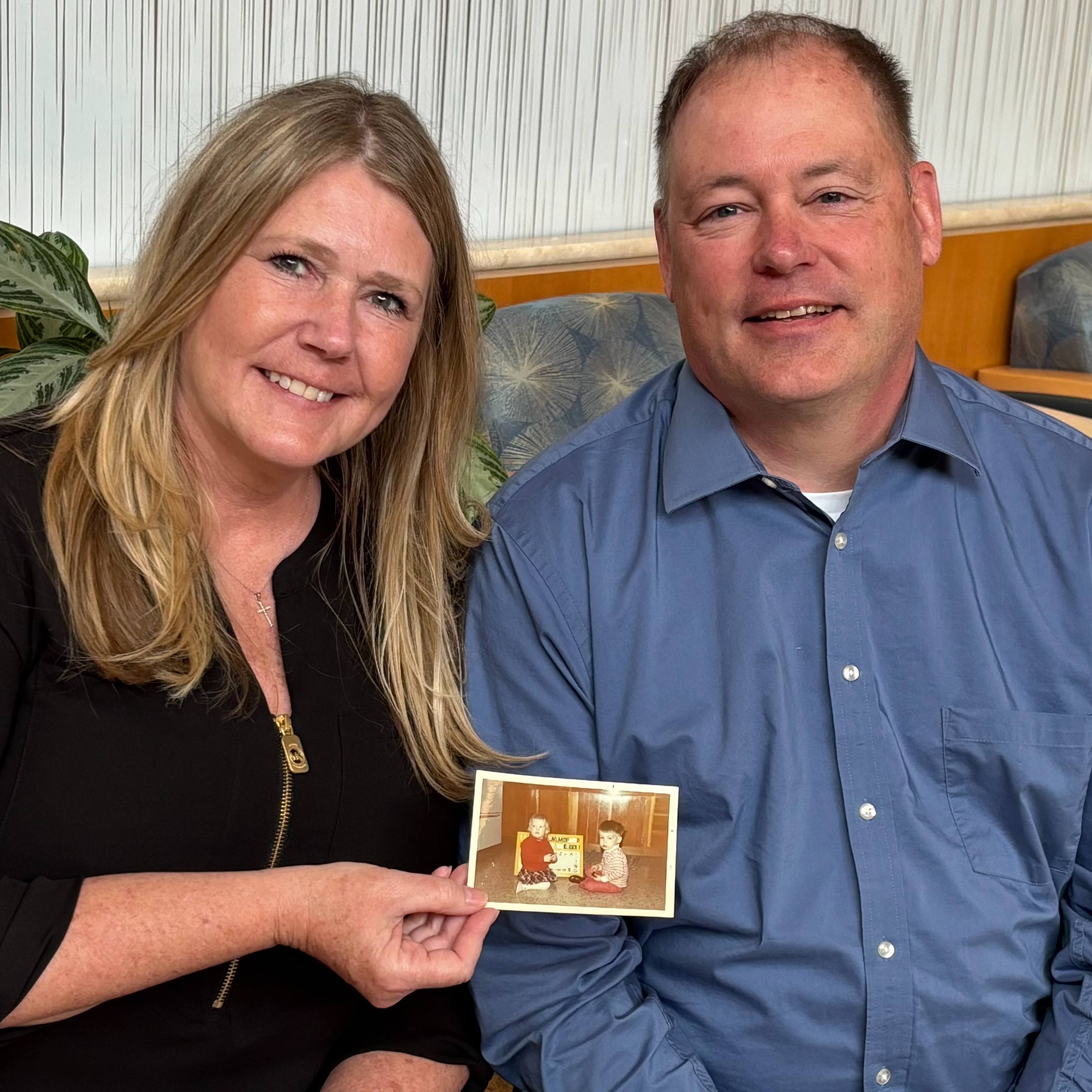-
Straightforward Approach Fixes Fibroids

When Karen Pauly began looking for treatment to address her painful uterine fibroids, she needed a care team that could take all her medical concerns into consideration. Karen took her quest to Mayo Clinic, where she received minimally invasive therapy that has dramatically improved her life.
When it comes to health care interventions, less is more for Karen Pauly.
Karen, a school psychologist, wife and mother of two teenagers, lives with a coronary microvascular disease that causes painful spasms of the small vessels around her heart. Because her condition is sensitive to stress and hormone fluctuations, Karen opts for low-impact treatment options to manage other health issues that arise.
So when Karen developed symptoms related to uterine fibroids, she set out to find a medical provider who not only understood the complexities of her underlying disease, but also respected her desire for minimally invasive care.
"Mayo Clinic was the only one that seemed to have knowledge about the spasms, and that brought me to Drs. Breitkopf and Stockland," Karen says. "They definitely recommended being careful about how best to treat the fibroids and a using a conservative treatment."
The option presented to Karen by Andrew Stockland, M.D., in the Department of Radiology, was uterine artery embolization. Dr. Stockland used the procedure to treat two uterine arteries that were supplying blood to Karen's fibroids. Within a few months, the bothersome symptoms related to her fibroids were all but gone.
"I was so impressed with the doctors and the respect they treat their patients with," Karen says. "They were very understanding about what I was going through."
Stressful symptoms
Karen developed the small vessel condition in 2014. When an episode hit, it hit hard. "It feels like a heart attack, actually," Karen says. "I'd get left-side pain in my chest and shortness of breath. I had to leave work a few times. If I was at home, I had to stop what I was doing and wait it out."
At the time, Karen sought help from specialists near home in St. Peter, Minnesota. Finding no answers locally about her unusual symptoms, she turned to Mayo Clinic. At the Women's Heart Clinic, Karen met cardiologist Joseph Murphy, M.D., who identified the syndrome and recommended treatment options.
"He was able to treat it, and in time, slowly, I got a little better," Karen says. "We started recognizing that one of the triggers for my coronary artery spasms was hormone fluctuation."
A few years after developing the small vessel condition, Karen noticed changes in her menstrual cycle. The duration increased from seven to 10 and then 14 days. At times, the flow became unmanageable. "The bleeding would get pretty significant to where I kind of got lightheaded," Karen says. "It limited my daily activities and social life."
"I was nervous about where to go for treatment because I wanted them to understand the coronary artery spasms and the relationship to hormones. That's why I ended up going back to Mayo Clinic."
Karen Pauly
Karen sought medical care for her heavy bleeding from her local gynecologist. Ultrasound imaging revealed she had developed uterine fibroids. "[The physician] wasn't too concerned and said to just watch it, but the symptoms kept getting worse each month," Karen says.
Fibroids are the most common, noncancerous pelvic mass in women. And unlike Karen's situation, they don't always cause symptoms. Uterine fibroids often are discovered during a routine pelvic exam or on an imaging test, such as an MRI, CT scan or ultrasound.
When fibroids cause symptoms, they can include heavy menstrual bleeding, extended periods, bleeding between periods, painful periods, back pain, pelvic pain, leg pain, increased frequency of urination, or bowel habit changes.
Collaborative approach
In addition to physical changes in her cycle, Karen experienced hormonal changes linked to the fibroids. It was an association that exacerbated her coronary issues and complicated a search for medical care.
"I was nervous about where to go for treatment because I wanted them to understand the coronary artery spasms and the relationship to hormones," Karen says. "That's why I ended up going back to Mayo Clinic."
In Mayo Clinic's Department of Obstetrics and Gynecology, Daniel Breitkopf, M.D., joined Karen's medical team and offered a variety of potential treatment options. This led to a meeting with Dr. Stockland.
"We take a multidisciplinary approach to our patients, with input from a variety of specialists," Dr. Stockland says. "This allows us to tailor the treatment options to each individual patient, keeping in mind the patient's needs, concerns, expectations and safety."
The premise of uterine artery embolization, which has been offered at Mayo Clinic for nearly 20 years, is straightforward, Dr. Stockland says. "We decrease the blood supply to the fibroids, and they shrink over time."
Expert care, ideal outcome
To prepare for the approximately 90-minute embolization procedure, which was performed using X-ray and video imaging equipment in a special, highly sterile procedure room, Karen was given a strong sedative and local anesthesia on the site near the incision on her upper thigh.
Dr. Stockland made a small incision into Karen's thigh to access her femoral artery and inserted a vascular sheath into the blood vessel. Through the sheath, a small catheter, just a few millimeters in diameter, was inserted and guided under real-time X-ray video equipment into Karen's right and left uterine arteries. Dye material injected into the catheter confirmed blood flow to the uterus and fibroids. Then tiny particles were mixed with the dye and slowly injected until blood flow to the fibroids stopped. The procedure, explains Dr. Stockland, treats all of a patient's fibroids, regardless of whether she has one or many.
After the procedure, Karen was admitted for overnight observation and given medications to control cramping and nausea that can occur as a result of the procedure.
"For patients like Karen who have multiple medical problems, improving one issue can sometimes have a positive domino effect on other symptoms."
Andrew Stockland, M.D.
"The doctor told me I would get sick and then get better, and that is what happened," Karen says. "Initially, I was violently ill, and I had to take narcotic pain relievers to help with the symptoms. But after two days, it did get batter. By the end of the week, I felt completely normal again."
The maximum benefit from the embolization procedure occurs between six and nine months after the procedure, but frequently symptoms improve within a few months. "We anticipate at least a 30 percent reduction in the size of each fibroid, and studies show the potential for even greater size reduction," Dr. Stockland says. "The overall size of the uterus decreases, as well, also contributing to symptom improvement."
Following the procedure, Karen noticed spasms related to her small vessel condition also seemed to get better. "I can't be sure if it's related to the procedure, but it sure coincided with when I got the procedure done," she says.
"For patients like Karen who have multiple medical problems, improving one issue can sometimes have a positive domino effect on other symptoms," Dr. Stockland says. "It was great to hear that not only her fibroid symptoms improved, but her general health overall improved. That is extremely satisfying to all of the members that took part in her care."
HELPFUL LINKS:
- Learn more about uterine artery embolization.
- Check out the Women's Heart Clinic.
- Connect with others talking about uterine fibroids on Mayo Clinic Connect.
- Explore Mayo Clinic.
- Request an appointment.







